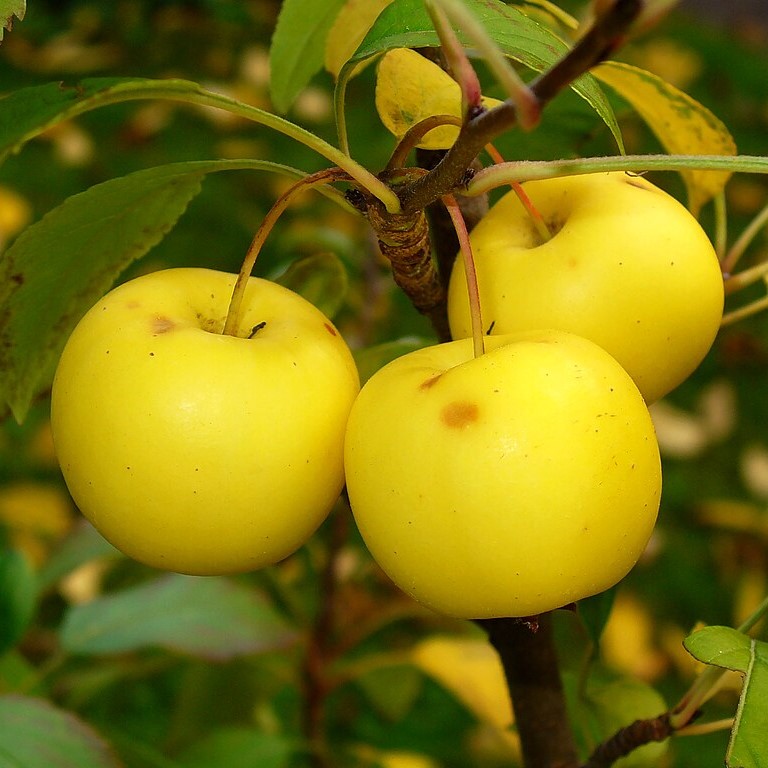Malus sylvestris
Overview
| Genus | Malus |
| Species | sylvestris |
| Common Name | European crab apple, European wild apple or simply the crab apple |
| Abbreviation | M. sylvestris |
| Ploidy | Diploid |
| Chromosome Number | 2n = 34 |
| Genome Size | 660 Mb |
| Genome Assemblies | 6 |
| Cross Reference | NCBI taxon: 3752 |
Organism Image

Description
Malus sylvestris, the European crab apple, also known as the European wild apple or simply the crab apple, is a species of the genus Malus, native to Europe and western Asia. Its scientific name means "forest apple".
The wild apple is a deciduous small to medium-sized tree, but can also grow into a multi-stemmed bush. It can live 80–100 years and grow up to 14 metres (46 feet) tall with trunk diameters of usually 23–45 centimetres (9–17.5 inches), although diameters exceeding 90 centimetres (35 in) have been recorded. The leaves are roundish-oval and sometimes hairy on the underside. The hermaphrodite flowers appear in May, slightly preceding hawthorn, have white or pinkish petals and are insect-pollinated. The small pome-fruits are around 3 centimetres (1.2 in) in diameter, ripen in autumn and fall to the ground. The bark is light brown and breaks up in flakes. The branches are thorny, especially in response to pruning or browsing.
European wild apples hybridise readily with domesticated apples. This can make identification difficult, as hybrids commonly exhibit traits that are transitional with respect to the two parent species. Generally, a reliable identification cannot be made without genetic testing, however, there are clues that can help identify individuals that are likely to be pure wild apples. Wild apple leaves tend to be somewhat smaller, stiffer and shinier. In comparison to those of both domesticated and hybrid apples, the underside of wild apple leaves also tends to be less hairy, often lacking hairs altogether. The crown of wild apples is also densely branched, whereas the crown of domesticated apples tends to be more loosely arranged with fewer, straighter branches. Finally, wild apple fruits tend to be smaller. The apples are usually below the threshold of 3 centimetres (1.2 in) in diameter, while domesticated and hybrid apples tend to be above. None of these features is entirely conclusive, however, and the best field identification results from their combined utilization.
Whole Genomes
Whole Genome Sequences & Annotations for Malus sylvestris
S genes
Malus sylvestris Haploid_Consensus_Whole_Genome_v1.0 S genes
| Query | Chr | Size(bp) | Coordinates | BLASTn Hit | BLASTn %ID | Domain |
| SFBB.XVI | Chr17 | 32456471 | 28522480-28523667 | MdSFBB.XVI-S9 | 98.737 | F-box; F_box_assoc |
| SFBB.XVII | Chr17 | 32456471 | 28568921-28567716 | MdSFBB.XVII-S9 | 99.42 | F-box; F_box_assoc |
| SFBB.XIV | Chr17 | 32456471 | 28571220-28572425 | MdSFBB.XIV-S9 | 99.254 | F-box; F_box_assoc |
| SFBB.Ib | Chr17 | 32456471 | 28646496-28645294 | MdSFBB.Ib-S9 | 99.584 | F-box; F_box_assoc |
| SFBB.VI | Chr17 | 32456471 | 28679574-28678396 | MdSFBB.VI-S9 | 98.219 | F-box; F_box_assoc |
| SFBB.III | Chr17 | 32456471 | 28755498-28756679 | MdSFBB.III-S9 | 99.408 | F-box; F_box_assoc |
| SFBB.XII | Chr17 | 32456471 | 28803288-28802116 | MdSFBB.XII-S9 | 94.629 | F-box; F_box_assoc |
| SFBB.X | Chr17 | 32456471 | 29082091-29080910 | MdSFBB.X-S9 | 91.709 | F-box; F_box_assoc |
| SFBB.Ia | Chr17 | 32456471 | 29117017-29115815 | MdSFBB.Ia-S9 | 91.771 | F-box; F_box_assoc |
| SFBB.Ic | Chr17 | 32456471 | 29153351-29152149 | MdSFBB.Ia-S9 | 97.257 | F-box; F_box_assoc |
| SFBB.XV | Chr17 | 32456471 | 29223430-29222216 | MdSFBB.XV-S9 | 95.802 | F-box; F_box_assoc |
| SFBB.IV | Chr17 | 32456471 | 29264726-29263542 | MdSFBB.IV-S9 | 97.126 | F-box; F_box_assoc |
| SFBB.II | Chr17 | 32456471 | 29274495-29273302 | MdSFBB.II-S9 | 96.315 | F-box; F_box_assoc |
| SFBB.V | Chr17 | 32456471 | 29313504-29312326 | MdSFBB.V-S9 | 97.373 | F-box; F_box_assoc |
| SFBB.VII | Chr17 | 32456471 | 29405636-29404455 | MdSFBB.VII-S9 | 95.737 | F-box; F_box_assoc |
| SFBB.XIX | Chr17 | 32456471 | 29508770-29507538 | ON918629.1, PbrSFBB.XIX-S17 | 96.756 | F-box; F_box_assoc |
| SFBB.XVIII | Chr17 | 32456471 | 29528626-29527442 | MdSFBB.XVIII-S9 | 96.203 | F-box; F_box_assoc |
| SFBB.XXI | Chr17 | 32456471 | 30337173-30338522 | MdSFBB.XXI-S9 | 99.63 | F-box; F_box_assoc |
| S-RNase | Chr17 | 32456471 | 28922861-28922610,28922462-28922028 | MG598501.1, S23-RNase | 100 | RNase_T2 |
Downloads
The Malus sylvestris S gene sequences are available in FASTA format.
| CDS and Protein (FASTA file) | S-gene_Malus_sylvestris |
Publications
Sun X, Jiao C, Schwaninger H, Chao CT, Ma Y, Duan N, Khan A, Ban S, Xu K, Cheng L, Zhong GY, Fei Z. Phased diploid genome assemblies and pan-genomes provide insights into the genetic history of apple domestication. Nat Genet. 2020 Dec;52(12):1423-1432. doi: 10.1038/s41588-020-00723-9.
Liu BB, Ren C, Kwak M, Hodel RGJ, Xu C, He J, Zhou WB, Huang CH, Ma H, Qian GZ, Hong DY, Wen J. Phylogenomic conflict analyses in the apple genus Malus s.l. reveal widespread hybridization and allopolyploidy driving diversification, with insights into the complex biogeographic history in the Northern Hemisphere. J Integr Plant Biol. 2022 May;64(5):1020-1043. doi: 10.1111/jipb.13246.